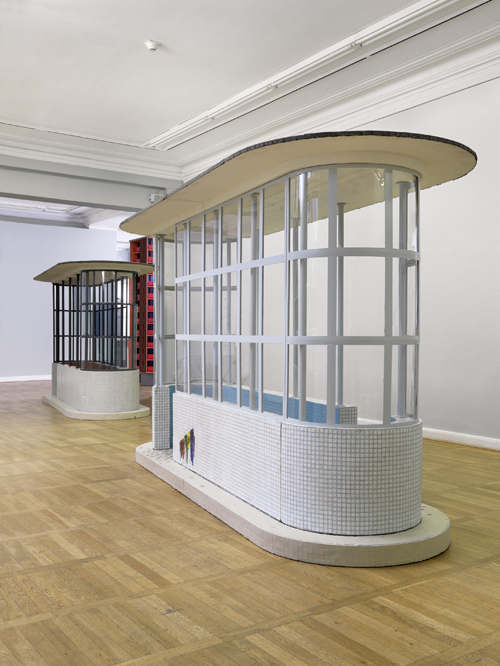Ina Weber
Haus am Waldsee
Haus am Waldsee

One enters Ina Weber’s exhibition Hier (Here) only to be immediately brought back outside. In the first room, Fußgängerzone (Pedestrian Precinct, 2001), an ugly ensemble of the kind typically installed in West German city centres, comprises a robust bench with a litter bin of the same colour, and a bulky concrete plant pot, complete with drooping pansies. Towering over all this is a slightly crooked streetlamp (maybe someone has kicked the junction box to knock out the light, a popular pastime among bored small-town teenagers). But rather than being simply brought inside as a full-size objects, the whole thing is faithfully scaled down. This transition involves a slight smoothing, an abstraction that makes Weber’s work sadder still: wretched, characterless functional architecture of the type found, as the title suggests, in any of countless pedestrian open-air malls used in post-war West Germany to cement over the scars of bombarded town centres.
This allusive opening to her solo show displays, in concentrated form, Weber’s overall approach: her art focuses on precisely this kind of nastily throwaway Modernist architecture, the sort that eventually lodges itself within the claustrophobic fug of everyday life. Her theme is urban space – the concrete-cast ideologies that shape it, the history evinced by its buildings. Consequently, alongside watercolours and mixed media works of housing projects, apartments full of rubbish, or the fully loaded vehicles of Shanghai trash collectors, the exhibition consists mainly of bus stops, tower blocks, fast food kiosks and smoking compartments, 1950s petrol stations and slightly shabby cafés. Each is built to scale. Most of these functional structures, based on real models, come in a strange intermediate size: too small to actually function, slightly larger than a model. One could also call them sculptures, ones whose dimensions relate to the human scales of viewer and maker.
Weber’s scaling down renders the objects comprehensible – in the sense of a literal ‘grasping’ – but not to the point of diminishing them. How quickly diminishment can actually happen is illustrated by a series of small architectural sculptures like Chinapfanne (Fried Noodle, 2012), Apartmenthaus Wedding (Apartment Block in Wedding, 2012), Kaufhaus (Department Store, 2009), or Invalidenstraße (2010), that stand in two long rows on the floor. Compared with adjacent works – the elegant, middle-sized bus stops Bus Shelter (glue) (2010) and Bus Shelter (come down) (2011), or the adjacent three-metre tall Hochhaus (rot) (Tower block, red, 2006) – these miniatures look just a little too cute, too much like a model toy kit and less like something odd that still needs to be taken seriously – something that demands to be engaged with. The same cannot quite be said, however, of Weber’s fantastic Trümmerbahnen (Rubble Tracks, 2004) that are permanently installed in the sculpture garden at Haus am Waldsee – here, miniature versions of various ruins and abandoned construction projects are inserted as decorative elements into the tacky small-format architecture of a mini-golf course.
For all the sadness and desolation they exude, Weber’s approach to these various architectures is always marked by a certain dignity. One might contrast Weber’s approach to Cyprien Galliard’s, for example, which celebrates Modernist architecture in a devastated testimony to an age that believed in the future, but with the kind of apocalyptic pathos available only to subsequent generations. Weber, who grew up in the Germany of the 1970s and ’80s, has experienced firsthand the leaden functionality of West German town centres. The helplessness of her functional buildings standing around in the exhibition space, stripped of their function and consequently rather lost-seeming, is not without a subtle, strangely jaded humour. Whereas the cuttingly subversive potbelly humour of Martin Kippenberger (who taught Weber in Kassel) emerged from the baths of steel of postwar silence, Weber’s wit is more the product of the concrete trough of progress: slow-flowing but insistent.
Translated by Nicholas Grindell














